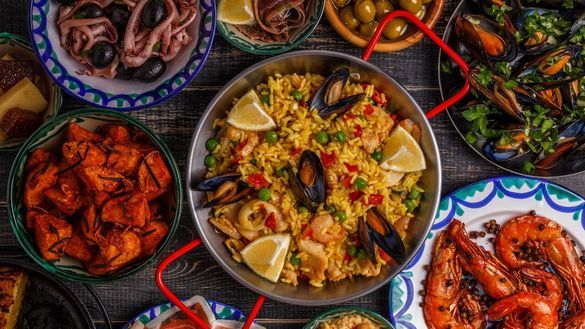 DISCOVER THE TASTES OF SPAIN: AT THE HEART OF ITS CULINARY EXCELLENCE LIES EXCEPTIONAL PRODUCE
DISCOVER THE TASTES OF SPAIN: AT THE HEART OF ITS CULINARY EXCELLENCE LIES EXCEPTIONAL PRODUCE
Six Spanish restaurants made The World’s 50 Best List of 2023 thanks to Spain’s diverse flavours regional, diversity and gastronomic traditions
Spanish cuisine is famous the world over. Not only for its fine dining and well-known chefs but also because the country boasts incredible natural resources that produce top rated ingredients, from seafood and ham to olive oil, wine and cider. Whether it’s at a Michelin-starred restaurant, a local market, or seaside shack, there’s regional influence, unique character and great history behind every dish.
For an outstanding Spanish culinary experience, savour some of the country’s tastiest experiences below:
Olive Oil – The Foundation of a Mediterranean Diet
Spain is the leading producer of olive oil. Even though most olives are grown in Andalusia, there are many other parts of Spain producing excellent oil, including Extremadura, Castile-La Mancha, Catalonia, the Region of Valencia, and Aragón. The abundance of olive oil has also triggered a boom in olive oil tourism forming part of the country’s wide-ranging culinary offering in recent years. Many olive oil producers have created unique experiences where visitors can discover the secrets of the most acclaimed olive oil in the world.
For one of the healthiest olive oil in the world, visit Requena, west of the Region of Valencia where a totally organic variety of olive oil is produced. In the province of Cáceres, travellers will find a tasting school, an oleoteque with more than 150 references of extra virgin olive oil, and the chance to make olive oil for themselves. Andalusia is the region with the largest olive oil production in the world. Visitors can tour an olive farm in a horse-drawn carriage, learn about olive picking, enjoying an authentic Andalusian breakfast or a picnic with local products.
Iberian Ham – A Culinary Treasure of Spain
Spain is full of culinary treasures, and one of them is Iberian ham. Everything contributes to making it delicious, from the region where it’s made to the way it’s cut. Guijuelo DOP ham is one of the most famous designations of origin, largely because it was the first to be created. It is produced in several municipalities in south-east Salamanca province, especially in the town of Guijuelo. Jabugo DOP ham, formerly known as “Huelva ham”, is made in the Sierra de Aracena and Picos de Aroche Natural Park, and in several villages in Huelva province, such as Cumbres Mayores, Cortegana, Encinasola and Jabugo – this last is one of the most famous ham producing towns in Spain. Los Pedroches DOP is the most recent designation of origin. This is a protected Designation of Origin, so the Iberico breed pigs must be raised, and the ham must be cured, only in the valley of Los Pedroches, in the north of Cordoba province. It is easy to recognise because the hams are longer and more slender than in the other regions.
Tipples to Tantalise the Tastebuds
Spain is also well-known for some of the best wine regions and grape varietals in the world (Tempranillo, Garnacha, Carignan, Verdejo to name a few), but Tenerife is often overlooked as a place to experience local tipples. Volcanic earth, Atlantic climate, and refined farming techniques. This formula is responsible for the special aroma and taste of wines from this part of Spain. A special mention goes to the malvasía wines, famous across Europe from the 16th century on. Writers like William Shakespeare, Lord Byron and Walter Scott discuss them in their work, and the leading courts and royal families of the continent used to drink them often. Guided tours, tastings with commentary and walks in the vineyards all make it possible to understand the characteristics and unique qualities of the five wine-making comarcas of Tenerife: Tacoronte-Acentejo, Ycoden-Daute-Isora, Valle de la Orotava, Valle de Güímar and Abona.
For the non-wine drinkers, head to one of Spain’s many cider producers. Cider, called Sidra in Spanish, is produced in the north of Spain, mainly in the region of Asturias, as Asturias is the main producer of cider, making up 80% of national production. A visit to a cider mill is a great experience and if travellers can visit during the harvest season, between October and November, even better.
Different Ways to Try
In addition to its regional specialties, Spain is home to numerous culinary festivals and markets that celebrate the country’s vibrant food culture. From the La Tomatina tomato fight in Buñol to the San Sebastian Gastronomika, a gathering of renowned chefs from around the world, these events offer unique opportunities to immerse in Spain’s culinary traditions and engage with passionate food artisans. For an authentic market experience, shop amongst locals at Mercado de la Esperanza in Santander; Bilbao’s Erribera Merkatua, the largest covered market in Europe; and Valencia’s Mercado Central De Valencia, also a Heritage of Cultural Interest site.
Spain invites travellers to enjoy its flavours, savour its authentic dishes, and witness the passion of its chefs and producers. Experience the joy of dining in bustling tapas bars, elegant Michelin-starred restaurants, and hidden gems tucked away in picturesque towns.
For more information on eating well in Spain visit www.spain.info/en/ or for inspiration follow @spain on Instagram.




















